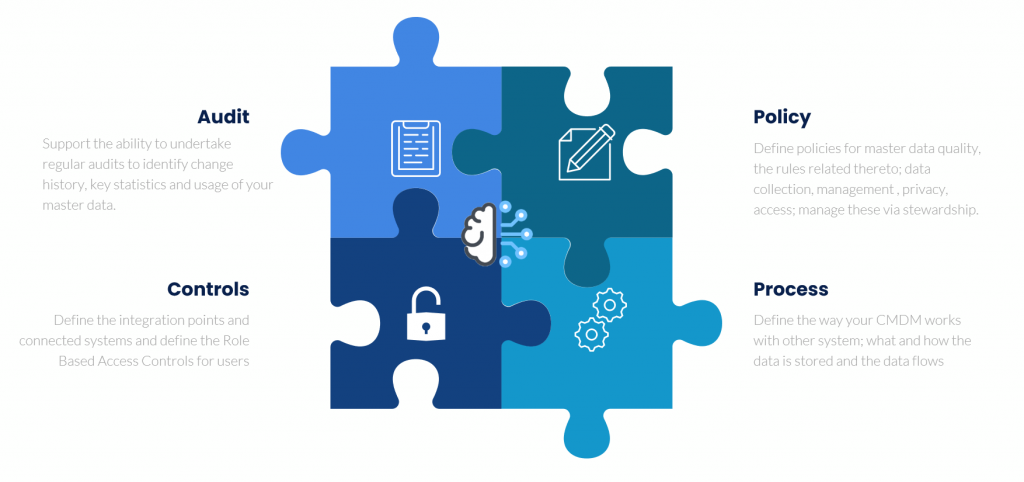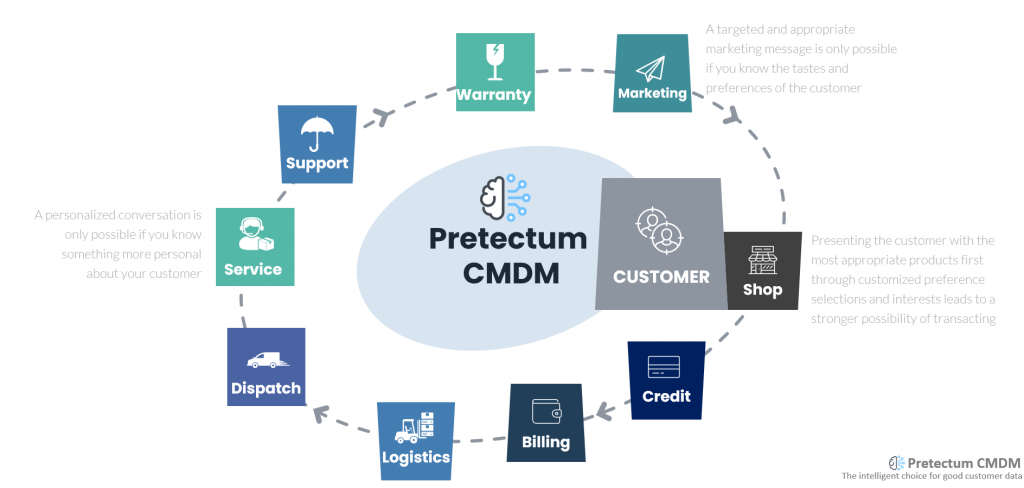Companies across industries are constantly trying to gain insights and actionable strategies to stay competitive and thrive. Traditional data warehousing has been a valuable tool for managing data but often falls short when it comes to unlocking the full potential of customer data.
The concept of Customer Data Platforms (CDPs) has emerged to serve a pivotal role in modern marketing. It is important though, to understand the differences between CDPs and other related systems such as Data Management Platforms (DMPs), Customer Relationship Management (CRM) systems, Marketing Clouds, and Customer Master Data Management (CMDM).
Customer Data Platforms (CDPs) represent a paradigm shift from traditional data warehousing approaches. They’re meticulously designed to offer businesses a holistic “360-degree customer view” at the master data and transactional level by seamlessly integrating a diverse array of first-party data sources into a unified and coherent storage infrastructure. At their core, they prioritize a customer-centric data model, which encompasses anonymous customer profiles, known leads, and existing customer data. Harmonization and correlation of anonymous IDs with internal customer IDs enable fluid data analysis and more effective segmentation.
What distinguishes CDPs from other marketing technology systems are both profound and essential for understanding their significance. First off, CDPs are purpose-built to provide a comprehensive and unified customer perspective. CDPs also consolidate data from various first-party sources into a single repository, promoting consistency and accuracy. The customer-centric data model of the CDP prioritizes the customer, ensuring that insights and actions are centered around individual customers. CDPs amalgamate data related to all customer stages, from anonymous visitors to long-standing clients, and then facilitate the correlation of anonymous and internal customer IDs, streamlining data analysis and segmentation. An important benefit from all this is empowering business stakeholders, such as CRM managers, to create and fine-tune customer segments. The relative versatility and seamless data exchange with various business intelligence (BI) systems, ad networks, and marketing tools give them an edge over other systems. Businesses can also execute segment activation within the CDP itself, providing flexibility and convenience all from one platform.
CDPs are up against a number of other technologies. DMPs for example, are renowned for their prowess in handling third-party data, often relying on anonymous profiles created through cookies with limited lifespans.

While DMPs excel in audience activation within ad networks, they have also started to incorporate first-party data as part of their functionality. Examples of DMP solutions include MediaMath, Adobe Audience Manager, Lotame, and Adform.
CRM systems, like CDPs, place a strong emphasis on customer profiles. However, they often fall short when it comes to mapping the journeys of anonymous users. The activation options in CRM systems are typically confined to email and telephone communication. Many CRM systems are also geared towards B2B interactions. Notable CRM systems include HubSpot, Salesforce, Zoho, Microsoft Dynamics, and SugarCRM.
Marketing cloud providers face the intricate challenge of integrating a wide array of solutions into a cohesive ecosystem. While facilitating the exchange of customer IDs across different modules, this means they may not always provide a comprehensive 360-degree customer view. Prominent examples of marketing cloud providers include Adobe Marketing Cloud, Salesforce Marketing Cloud, Oracle Marketing Cloud, IBM Marketing Cloud, and Marketo.
The CMDM is designed to maintain a single, accurate, and consistent version of customer master data across the entire organization. Here the focus is on the core customer data elements, such as names, addresses, contact information, and identifiers but platforms like the Pretectum CMDM provide no prescription regarding what you can store and manage. The CMDM primarily serves data governance, data quality, and compliance needs.
Technology Selection factors
A keen focus in the CDP is the capability to import and amalgamate diverse data types, thereby furnishing businesses with a comprehensive view of their customers. The data typically gathered and integrated into CDPs encompass a multitude of facets including Clickstreams, Behavioral Data, Customer Data, Transaction Data, Campaign Data, Customer Care Data, offline data, and enriched data.

Given the specialized nature of CDPs and CMDM platforms, it is important to recognize that the CDP is primarily geared toward marketing and customer engagement, emphasizing personalized experiences and campaign optimization.
CMDM has a broader organizational focus, ensuring data accuracy and consistency of the customer master across all departments and systems, with an emphasis on data governance and compliance.
CDPs prioritize a customer-centric data model, encompassing known and anonymous customer profiles and behavioral data.
The CMDM adopts a customer-master data-centric model, it is a subtle difference. Here the CMDM focuses on core customer attributes like names, addresses, and identifiers, with an emphasis on data quality and accuracy.
CDPs and CMDM integrate with a wide array of data sources, with CDPs focused often on marketing activities.
CMDM platforms consolidate and manage core customer data elements from internal and external sources, ensuring data integrity and compliance.
CDPs are tailored for marketing-specific use cases, such as audience targeting, personalization, and campaign activation, optimizing customer acquisition and retention; the CMDM primarily focuses on data governance, data quality, and compliance, serving broader organizational needs for clean and consistent data.
CDPs seamlessly integrate with ad networks, marketing tools, and BI systems, with a primary focus on enabling marketing campaign activation. CMDM focuses on integrating core customer data across enterprise systems, prioritizing data quality and governance over marketing campaign execution.
CDP selection criteria revolve around marketing-specific features, real-time capabilities, and campaign activation capabilities. CMDM selection criteria will often emphasize data quality, governance, compliance, scalability, and integration with existing systems.


